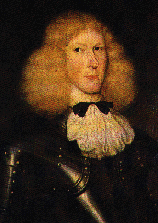Robert Campbell of Glenlyon
Robert Campbell , 5th Laird of Glenlyon (* 1630 - 2 August 1696 in Bruges ), was a Scottish nobleman and military. He became known as the commanding officer of the government forces that carried out the Glencoe massacre in 1692 .
Life
Robert Campbell was born in 1630 in Glen Lyon to Archibald Campbell, the 4th Laird of Glenlyon and a member of the Campbell clan . From his father he inherited Meggernie Castle in Glen Lyon, which he built and expanded at great expense. In 1663 he married Helen Lindsay . The couple had three sons and four daughters. The complex expansion as well as addiction to drinking and gambling led to Campbell gradually becoming deeply in debt. In 1684 he had to sell almost all of his property to the Earl of Tullibardine , only the smaller property Chesthillat the end of the valley of Glen Lyon he remained In 1689 this property was sacked by the Jacobite MacIains of Glencoe, relatives of the Clan MacDonald of Glencoe, who had long been enemies with the Campbells, after the Battle of Dunkeld . In the same year he enlisted for lack of money at the advanced age of 59 as an officer in the Earl of Argyll's Regiment of Foot and received the rank of captain .
After the Glorious Revolution , many Scottish highland clans rebelled against the new government of King William III. (in Scotland William II.) and Queen Mary II. , but were militarily defeated several times. In August 1691 the king finally offered the clan chiefs an amnesty if they swore allegiance to him by the end of the year. Alastair MacDonald of Glencoe missed this deadline and the government decided to make an example of him. Captain Campbell, who had been quartered with the MacDonalds in Glencoe with about 120 soldiers from his regiment since the end of January 1692 , was ordered to kill all MacDonalds on February 12th. He carried out this order in the Glencoe massacre . 38 men, including Alastair Mac Donald, were killed by the soldiers, about the same number of MacDonalds were killed while trying to escape in the snow storm .
The massacre caused widespread public outrage and John Dalrymple, 1st Earl of Stair , Secretary of State for Scotland, was forced to resign. Robert Campbell was used with his regiment in the Palatinate War of Succession in 1695 and fought in the Spanish Netherlands . However, the regiment was captured by the French at Diksmuide . Campbell thus escaped legal prosecution. He was transferred to Flanders a few days after the Scottish Parliament set up a commission to investigate the massacre. The order given by the Commission after the investigation to bring him back to Scotland probably failed to reach him. Robert Campbell died in Bruges on August 2, 1696 , allegedly as an alcoholic in the gutter . Some of his descendants saw the "curse of Glencoe" lying on the family. None of his grandchildren married and the family died out with the death of his last grandson at the end of the 18th century. The family property, which Campbell's son Iain had gradually regained, fell to distant relatives, whose descendants sold them to Donald Currie in 1885 .
Individual evidence
- ↑ Duncan Campbell: The Lairds of Glenlyon: historical sketches relating to the districts of Appin, Glenlyon, and Breadalbane , Privately Printed, 1886, on archive.org (English)
- ↑ perthshirediary.com: The Curse of Glencoe on the Glenlyon Campbells ( Memento of the original from March 12, 2015 in the Internet Archive ) Info: The archive link has been inserted automatically and has not yet been checked. Please check the original and archive link according to the instructions and then remove this notice.
Web links
- Kurzbiografie on undiscoveredscotland.co.uk (English)
- The Curse of Glencoe and the Campbells of Glenlyon (English)
| personal data | |
|---|---|
| SURNAME | Campbell, Robert, of Glenlyon |
| ALTERNATIVE NAMES | Campbell, Robert |
| BRIEF DESCRIPTION | Scottish nobleman and officer |
| DATE OF BIRTH | 1630 |
| DATE OF DEATH | 2nd August 1696 |
| Place of death | Bruges |

